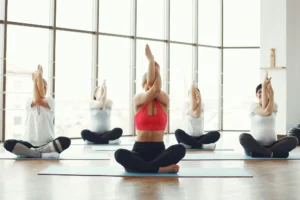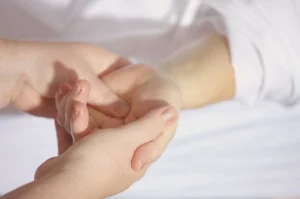Menopause is a normal phase in a woman’s life. Yet, it may also be an episode of significant change, and women suffer several symptoms when their hormone levels vary, including hot flashes, nocturnal sweats, exhaustion, depression, anxiety, and vaginal dryness. These symptoms can exacerbate stress and anxiety, making it harder to relax.
Are you suffering from menopause symptoms? How are you coping with menopause symptoms?
Several excellent menopause relaxation techniques can help women cope with menopausal symptoms and reduce stress. Here are a few of them discussed in this article.
Deep breathing
Deep breathing for menopause is a simple yet powerful method for relaxing the body and mind. Find a quiet place to sit or lie down, close your eyes, and focus on breathing. Deeply and slowly inhale through your nose, filling your abdomen with air. Retain your breath for several seconds before exhaling through your mouth. Repeat for 5–10 minutes.

Meditation
Meditation is a mind-body exercise in which you focus on the present moment. There are different kinds of meditation, including quieting the mind and letting go of problems and ideas. Meditation may be practiced for just five minutes daily, significantly impacting stress levels.

Yoga
Yoga for menopause relief is a physical and mental activity comprised of postures, breathing exercises, and meditation. Yoga may aid with flexibility, strength, and balance, as well as stress and anxiety management. There are several styles of yoga, so you may select one that suits you.

Massage therapy
Massage therapy for menopause is a hands-on treatment that helps to ease tension in the muscles, enhance circulation, and reduce stress. A professional massage therapist can perform massages. It has the following physical benefits:

- Improved circulation
- Reduced muscular stiffness
- Reduced Joint inflammation
- Sleeping better
- Improved adaptability
- Less pain and soreness
- Enhanced immunological response
Here are some more calming ideas for menopause:
- Get some rest. You can cope with stress better if you get sufficient rest.
- Have a healthy diet. Consuming plenty of fruits, vegetables, and nutritious grains can help to enhance mood and anxiety reduction.
- Regular exercise is essential. Exercise is a fantastic way to reduce stress and improve overall health. Aim for a minimum of 30 minutes of moderate-intensity exercise on nearly every day of the week.
- Spend time with family and friends. The effects of stress may be reduced through social support. Spend time with family and friends that you enjoy.
- Take frequent breaks during the day. When you feel anxious, take a few minutes to step away from what you’re doing and relax.
Menopause cannot be prevented. However, you may take action to maintain your wellness in your later years. Healthy practices can help relieve some of the symptoms of menopause and avoid consequences. Maintain a healthy weight, eat a well-balanced diet, and exercise regularly.
What is the usual incidence rate of heat flashes?
A hot moment may last one to five minutes and happen multiple times per week for some women or regularly for others. Hot flashes may happen four or five times per hour or 20 to 30 times daily when severe. There are many options to deal with heat flashes. First, some lifestyle adjustments may be helpful, such as
- keeping calm, wearing clothes in layers, carrying a small fan, and drinking cold liquids.
- Avoid meals and drinks that might cause heat flashes, such as alcohol and coffee.
- If you smoke, you should stop.
- If you are overweight, you must lose weight.
Hormonal imbalance during menopause causes a decrease in estrogen levels, which may result in hypersensitivity to variations in body temperature, which may lead to menopausal hot flashes
.
Here are a few natural methods for menopause hot flash relief
- Regular Exercise: Have an average level of physical exercise to maintain your hormonal balance and manage symptoms.
- Intake of fruits and vegetables: Increase your daily intake of fruits and vegetables for better overall health.
- Temperature-Controlled Diet: Avoid hot and sweet meals in favor of cooling options.
- Hydration: Drink plenty of water to keep your body temperature stable and hydrated.
- Smoking: stop smoking, which may exacerbate hot flashes and other menopausal symptoms.
- Cooling Methods: Use cooling techniques such as wearing breathable clothing and staying in areas with good ventilation.
- Stress Reduction: Make use of relaxation techniques, including deep breathing and meditation, to reduce stress, which can be a cause of hot flashes.
Can exercise help to lower menopause symptoms?
Undoubtedly, menopause is one of the most crucial times in your life to start exercise. Regular exercise may prolong your life and enhance your quality of life. In addition, it helps to reduce menopausal symptoms. If you think this could be too good to be true, consider the following particular ways that exercise helps relieve typical menopausal symptoms: Menopause tends to slow down metabolism, which makes it more challenging to maintain or lose weight, which is one of the main reasons for frustration. Any healthy weight loss program should always include exercise, which can help you maintain a healthy weight.
Low self-esteem:
As a result of the stigma associated with menopause, you can experience a decrease in your sense of confidence. Exercise greatly enhances confidence since it increases physical and psychological strength and endurance.
Cardiac health:
When menopause first begins, estrogen levels often drop, which may trigger levels of both good and bad cholesterol to rise. It may also increase your chance of developing heart conditions. Along with a healthy, balanced diet, exercise keeps your heart pumping, which lowers your risk for cardiac problems and helps to maintain cholesterol levels.
Exercises that are best for menopause:
Try for at least 20 minutes of moderate to vigorous activity almost every day of the week to experience the most benefits of exercise during menopause. A variety of activities include mild to strenuous exercise. The following are some instances of physical activity:
- Pilates or yoga
- Weight lifting exercise
- Jogging /walking briskly
- Cycling
- Dancing
- Swimming
The most important consideration is to choose things you love. It will not only improve your attitude and sense of self-worth, but it will also support you to continue your exercise habits. Your mental well-being is another essential component that you need to maintain regularity.
What advantages does exercise have?
- Exercise has many more benefits than only helping someone to lose weight.
- Exercise may improve mental health, including the control of stress and anxiety. Additionally, it can lessen the effects of mental deterioration caused by aging.
- Regular exercise may also enhance the quality of your sleep.
- Contrary to common assumption, additional short-term benefits exist, such as alleviating stomach discomfort and joint and muscular stiffness. Regular strength training helps to develop and maintain muscle mass, which will raise metabolism.
- Weight-bearing exercises assist in strengthening bones and increasing bone density.
- To prevent bone fractures and an increased risk of falling, maintaining excellent bone health is essential throughout perimenopause and menopause when lowering estrogen causes more significant losses in bone density.
By lowering blood pressure, regular exercise also promotes heart wellness. Even the heart rate at rest can be reduced. Estrogen, known as protective against heart disease, is lost after menopause, increasing a woman’s chance of developing heart disease. Heart disease is one of the leading causes of mortality in postmenopausal women.
How can I begin to move more?
Knowing where to begin with fitness may take time, especially if you last exercised a long time ago, or possibly ever. It doesn’t have to be that way. The following suggestions may be helpful:
- Begin gently with a moderate workout, such as a 15-minute walk. Time and intensity can be increased as your fitness and consistency improve.
- Find your motive for exercising and use it. Make fitness a priority, whether moving your body more to lower your risk of heart disease, having more energy to play with your children and grandkids, or getting back into a once-favorite outfit.
- Find a companion to work out or check in on your progress.
- Explore with something new. Try a new workout class or an online workout. Cycling, swimming, dancing, and other activities are all acceptable. Exercise isn’t simply about going to the gym.
- Enjoy your accomplishments, no matter how minor. Every time you exercise, you improve your health.
- If pelvic floor weakness prevents you from moving forward, see a women’s health physiotherapist for more specific guidance on enhancing your pelvic floor health.



